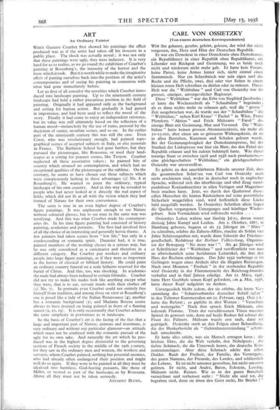ART
An Ordinary Painter
WHEN Gustave Courbet first showed his paintings the effect produced was as if the artist had taken off his trousers in a public place. The shock was actually moral ; it was not only that these paintings were ugly, they were indecent. It is very hard for us to realise, as we go round the exhibition of Courbet's painting at Rosenberg's, the intensity of the horror and the form which it took. But it is worth while to make the imaginative effort of putting ourselves back into the position of the artist's contemporaries and of seeing his painting in connexion with what had gone immediately before. Let us first of all consider the novelties which Courbet intro- duced into landscape painting. Up to the nineteenth century landscape had held a rather precarious position in the field of painting. Originally it had appeared only as the background and setting for human action. But gradually it had gained in importance, and had been used to reflect the mood of the story. Finally it had come to enjoy an independent existence, but its value was still ultimately based on the reflection of a human mood—melancholy by the use of ruins, pastoral by the depiction of sunny, arcadian scenes, and so on. In the earlier part of the nineteenth century this was still the case. Even Corot, who was revolutionary enough, had painted topo- graphical scenes of accepted subjects in Italy, or else pastorals in France. The Barbizon School had gone further, but they pursued the picturesque, like Rousseau, or used their land- scapes as a setting for peasant scenes, like Troyon. Courbet neglected all these associative values ; he painted bits of country which aroused no contemplation, and which had no exceptional qualities of the picturesque or the sublime. On the contrary, he seems to have chosen out those subjects which were conspicuously lacking in these advantages (cf. No. 6 at Rosenberg's). He wanted to paint the ordinary, typical landscape of his own country. And in this way he revealed to people who had never looked at it directly the real aspect of fields, which did not fit at all with the vision which they had formed of Nature for their own convenience.
The same is true in an even higher degree of Courbet's figure paintings. It was unpleasant enough to see Nature without coloured glasses, but to see man in the same way was terrifying. And this was what Courbet made his contempor- aries do. In his time figure painting had consisted of history painting, academies and portraits. The first had involved first of all the choice of an interesting and generally heroic theme. A few painters had taken scenes from " low life," but only in a condescending or romantic spirit. Daumier had, it is true, painted members of the working classes in a serious way, but he was only considered as a caricaturist and therefore in a different category. But Courbet put workers and ordinary people into large figure paintings, as if they were as important as the heroes of classical or biblical history. He could paint an ordinary country funeral on a scale hitherto reserved for the burial of Christ. And this, too, was shocking. In academies the nude had always been reduced to certain formula:. Courbet did not try to make his nudes look like anything except what they were, that is to say, servant maids with their clothes off (cf. No. 7). In portraits even Courbet could not entirely free himself from tradition, and among those on view at Rosenberg's one is posed like a lady of the Italian Renaissance (4), another has a romantic background (3), and Madame Boreau seems always to have insisted on being painted in front of a flaming sunset (9, to, 19). It is only occasionally that Courbet achieves the same simplicity in portraiture as in landscape.
So the basis of Courbet's art is the facing of the fact that a large and important part of Nature, animate and inanimate, is very ordinary and without any particular glamour—an attitude which must not be confused with the romantic pursuit of the ugly for its own sake. And naturally the art which he pro- duced was in the highest degree distasteful to the governing sections of French society in the middle of the 19th cantury, for they saw in the ordinary men and women, the workers and servants, whom Courbet painted, nothing but potential enemies, who had already often endangered their position and might well do so again. If they were to be painted at all they must be idealised into harmless, God-fearing peasants, like those of Millet, or treated as part of the landscape, as by Rousseau. Above all they must not be taken seriously. ANTHONY BLUNT,














































 Previous page
Previous page